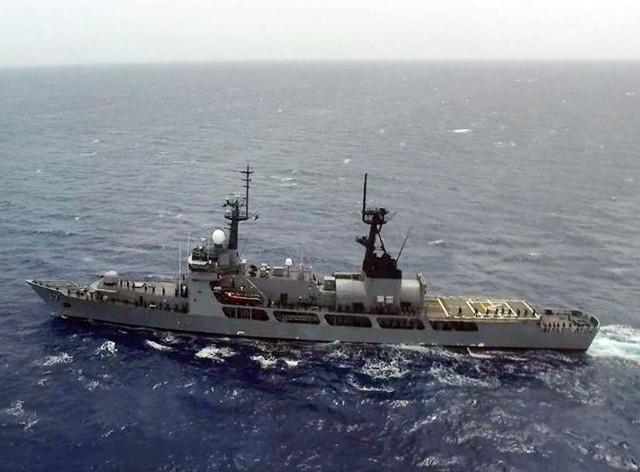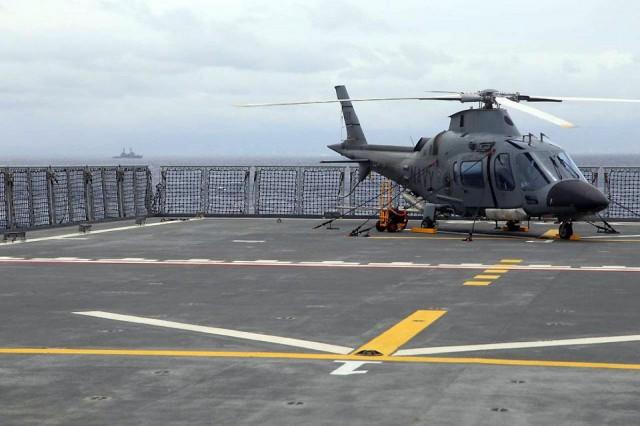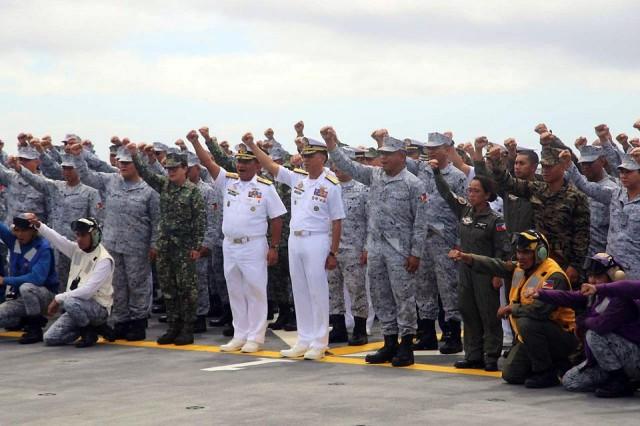PHL Navy sees bright future after RIMPAC experience
A strong wind had picked up, buffeting the Agusta helicopter as it circled down toward the two Philippine boats steaming past Hawaii’s famous Diamond Head National Park.
The Philippine flag had been painted on the BRP Davao del Sur’s top deck, breaking the otherwise ashen profile of one of the country’s newest ships.
A few miles away, its silhouette almost obscured by a slight squall, BRP Davao del Sur watched over her compatriot ship.
Both ships — as well as the Philippine Navy and the Marine personnel on-board — bear the honor of being the first Filipino participants in the biennial Rim of the Pacific Exercises.

An estimated 47 surface, five submarines and over 200 aircraft and 25,000 personnel round off the large multinational contingent.
The wind had forced the Agusta helicopter to approach the ship’s landing dock slightly to the right. Despite the rolling and pitching ship, the pilots set us down with no drama.

Rear Admiral Robert Empedrad, the Philippine Navy's overall commander, arrived on an earlier helicopter flight and had just given a pep talk to the crew of the ship.
Empedrad is optimistic that the Philippines' participation in the naval exercises marks the beginning of even greater involvement of the Philippine Navy and a sign that it is well on its way to achieve its goals of modernization.
“This is enormous as far as training is concerned. Sailors and Marines will be exposed to various training that involves other foreign navies,” Empredad said
There was a noticeable buzz among the sailors as we gathered for a simple lunch of pork adobo, pancit and fried eggplant. The food had been poured over generous helpings of rice, and spread across the long tables of the enlisted men’s mess hall. It is a tradition meant to celebrate the collective spirit among military personnel. Empedrad led the simple ceremony, eating with his hands and sharing the piles of food with his men.
They told me morale is high onboard the two ships. For over a month, the Philippine troop carrier and frigate had been practicing off the Hawaiian island chain with some of the most modern navy vessels in the world.

The BRP Andres Bonifacio had successfully fired its 70mm cannons at floating targets at sea and the lone Navy helicopter had made landings on different ships participating in RIMPAC, or Rim of the Pacific Exercise.
Philippine Marines had launched assaults on make-believe adversaries from their own landing crafts, holding their own and even impressing their foreign counterparts.
Overall, the Philippine Navy believes this strengthened the interoperability of participant nations in case a scenario arises where they all have to work together.
Navy Ensign Jillian Omac was among the many who felt privileged to be part of the first Philippine contingent to directly participate in RIMPAC since it was started in the early 1970s.
"We are so proud na sa ngayon hindi lang tayo observer but participant na po tayo dito. It is a great pride and honor na dalawang ship din ang pinadala natin dito which means the Philippines is really doing well,” she said.
An eye on the future
While the country acquires more surface ships like frigates and long-range patrol aircraft, Empedrad said he believes the future lies beneath the water.
President Rodrigo Duterte, he said, had already given the go-ahead to begin acquisition of submarines in the next few years.
"If we have submarines it will serve as a strong deterrence and nobody will bully us," said Empedrad.
Empedrad, however, was quick to point out that the planned acquisition of more naval assets and future participation in the US-led exercises do not mean the country is favoring US relations over China.
He said the country will still pursue military relations with other countries not identified with the US like Russia.
Next month, one of the Philippine frigates for instance is set pay a goodwill visit on a yet undisclosed Russian port.
China is conspicuously absent in RIMPAC, despite participation in 2014 and 2016. the US had withdrawn its invitation to the rising naval power this year because of its activities in the South China Sea.
US Indo Pacific Command Commander Admiral Philip Davidson said the Chinese had reneged on earlier promises not to militarize the South China Sea.
China not being invited to this year's RIMPAC, he said, is a direct response.
“The Chinese promised they would not militarize those outposts in the South China Sea. Straight up I can say that’s why they were disinvited to RIMPAC,” Davidson said in a press briefing inside the US Indo Pacific Command Headquarters in Hawaii.
The US had previously said it has intelligence information indicating China had put missiles and jamming equipment on the artificial islands they had built in the disputed areas claimed by the Philippines and other Asian nations in the South China Sea. —KBK, GMA News



